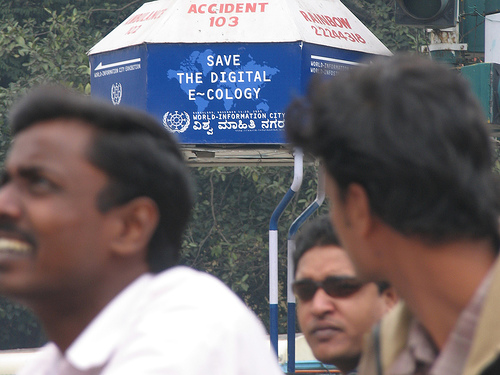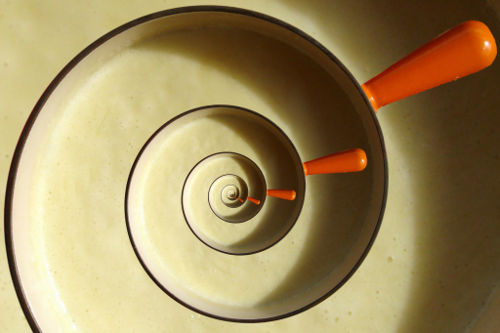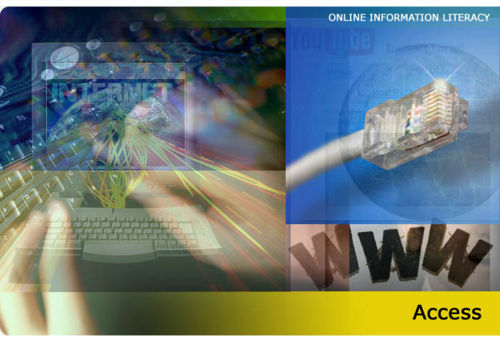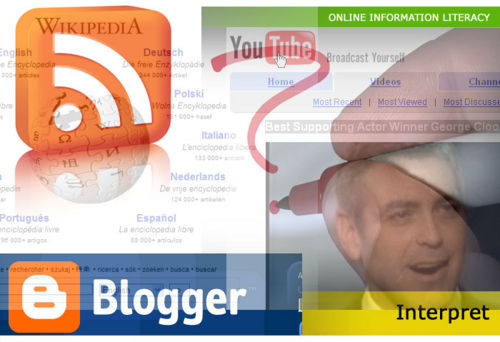Digital information literacy
Information Literacy is defined as the lifelong ability to recognise the need for, to locate, evaluate and effectively use information (American Library Association, 2006). Digital information literacy is one aspect of this and very relevant for the 21st Century. Another term used in this context is fluency and this is where the following definition sits:
- "Digital Information Fluency (DIF) is the ability to find, evaluate and use digital information effectively, efficiently and ethically. DIF involves knowing how digital information is different from print information; having the skills to use specialized tools for finding digital information; and developing the dispositions needed in the digital information environment." 21st Century Digital Information Fluency (DIF) project and model
For the purposes of this resource, the following terms will be used as they denote a broader context for digital information literacy: access (find), interpret (evaluate) and create (use).
The ability to access , interpret and create digital information has increased its level of importance in the continuum of literacy in recent years. This is because the use of computers, the Internet and the World Wide Web has become integral to many forms of information access, communication, and knowledge generally. This change is having an impact on common understandings about information, communication and knowledge - causing many to ask fundamental questions like: what sort of information do I need, how do I find it and in what form do I need it to be? what is reliable information? How do we communicate effectively? and how do we develop and maintain knowledge?
- Check out these online information literacy modules which take you through searching, evaluating and using information of various kinds.
A stimulating way to think about all this is by watching the Shift Happens video.
Contents
List of learning objectives
The following learning objectives are mentioned in the scenario:
- Demonstrate and apply knowledge of a personal computer system
- Demonstrate how to establish a connection to the Internet
- Demonstrate navigation skills using a browser
- Explain copyright of digital works
- Use social bookmarking to store and retrieve information
- Use RSS to store and retrieve information
- Create and maintain a basic weblog
- Work cooperatively using workgroup computer software
- Introduction to creating digital audio, video and images
Scenario
Following is a scenario to assist people to understand and move through the learning objectives:
Tiff is doing a project about climate change and sustainability. She is looking for resources about climate change and how it is affecting social, economic and environmental sustainability. If Tiff can access the Internet, she has access to a very large range of information including books, animations and software, audio and video, and opportunities to meet and communicate with experts and other people working on sustainability.
A spiral of knowledge
As Tiff moves through her project consider the following three steps in her process:
- access
- interpret and
- create
Access, interpret and create are applied here as processes in a spiralling relationship. For example, when creating a digital photo, this involves knowing how to access a camera, interpreting how it works, and then creating the picture on the digital camera's storage disk. Access, interpret and create exist within and beyond these steps in digital photography. Loading the picture to a computer for editing involves accessing the computer, accessing the files on the camera, and accessing the software to display and edit the image. Next is the need to interpret the image, the software, and the editing requirements. And last but still not finally is the ability to create (edit being the same) an image, create backup files, create published versions, etc. As we can see, the three broad categories of access, interpret and create exist within and beyond the steps in this example - and so, the spiraling analogy used to explain the reasoning for the three categories.
Consider Tiff as she approaches her project. First she will need access to a computer, then to the Internet, then to the information she is looking for. Along the way she will need to interpret what she finds and make decisions on what next to try and access. To assist with this she may use a weblog to create notes on what she finds. She may use images, audio and video in her notes, and by doing so create new versions of information that is useful to another person who happens to have a project on sustainability. Tiff may find herself using the Internet and the information she finds to communicate with other people. These people may have other information that Tiff has not yet found. By working together they will be able to access, interpret and create a wider range of information, often at a faster rate, and assist each other on their work. In all these instances there is a spiral of access, interpretation and creation of information.
Let's join Tiff now as she prepares to access a computer and connect to the Internet.
Accessing a computer and the Internet
- Demonstrate and apply knowledge of a personal computer system
- Demonstrate how to establish a connection to the Internet
- Demonstrate navigation skills using a browser
Tiff now has access to the Internet and is ready to start finding information on her project. There are many ways to access the Internet. You will often find that many libraries or other public services provide access to the Internet. In many cities and tourist destinations there can often be found Internet cafes where people pay to use a computer and the Internet. Schools, colleges and universities often provide access to the Internet, and many mobile phones and similar devices have the ability to access the Internet.
Let's rejoin Tiff as she settles in to her computer and starts to access and interpret information on the Internet.
Accessing and interpreting information from the Internet
Tiff is starting to find a very large amount of information on her project. Some of it is very useful, some of it is incomplete, and much of it leads to other interesting topics. She is finding it quite difficult to manage all this information. For now there are a few things she can do to store and keep track of things while she continues to browse all that she finds.
There are quite a few information resources that appear to be continuous works in progress. There are websites that broadcast audio recordings of upcoming conferences, speeches and interviews; there are video sites that are doing similar; there are many sites that are the continuous notes and bookmarks from other researchers. All of these sites promise to have information in the near future that Tiff could find useful and so she needs a way to be kept informed of the new information coming onto those websites.
Tiff is now awash with new information. Its time she stopped and took stock of it all. Thankfully she has been careful to keep clearly described bookmarks, and the RSS feeds have not only delivered some very useful information but have given her an idea on how to interpret the information she has gathered so far. Tiff wants to make notes on what she has found, and the ideas she has so far. Her head is so full that if she doesn't create something from it all she won't be able to go any further without forgetting what she knows now. Many of the websites she found were simply the notes of other people researching similar projects. Tiff thinks it might be a good idea to make notes in a weblog of her own, so others can find her work sometime and see what information she found useful.
- Explain copyright of digital works
Let's rejoin Tiff as she prepares to start her weblog and create notes on the information she has gathered so far.
Creating to interpret information from the Internet
Soon after starting a weblog and leaving comments on other people's weblogs Tiff has had people leave comments on her blog. Many of the comments have been helpful in pointing out mistakes or pointing her to better versions of information. Tiff is discovering that through communicating with other people through the Internet she gets pointed to more relavent information. Tiff has found a number of other people who are working on similar projects, and wants to work with them to see if together they can access, interpret and create better information.
Tiff and her new colleagues have made excellent progress on their projects together but find themselves limited by their abilities to work with multi media. They want to create their own audio and video files, and use images in their work. They all agree to learn a bit more about multi media and apply it in their collaborative work.
Conclusion
By now you should have completed the activities assigned to all the learning objectives listed in the above scenario. By following the scenario you will have attempted the learning objectives in an order in which they may typically appear for you when you attempt to use them in your own work. We hope that you have learned new skills and knowledge through this course, and where there are gaps, errors or areas that are too difficult, you will have either edited the page or left a note on the discussion area for the page to help us improve this resource.
temporary note: old content has been moved to discussion area.



